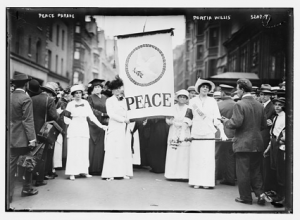
Photo from Women’s Peace Parade, August 29th, 1914
At the onset of the Great War in 1914, thousands of women descended on New York in the first-ever women-only protest against American participation in war. Photographers found women wearing black, a symbol of death, contrasted by one woman wearing white (symbolizing life) holding a peace flag. The beginning of the 20th century brought women into the public sphere in an unprecedented fashion. Women were eager to redefine their role in society and demonstrate that, as half the populous in America, their voices deserved to be heard as well[1]. The push for peace resonated especially deeply with women because they bore the brunt of conceiving, raising and protecting the life of a child[2]. The opening to redefine women’s role in political society came with World War One. Brave women used marches like this to assert that as half of the American population, their antiwar position deserved to be represented in the government. Most women found that not only were they opposed to the governments actions, but their voices were ignored in the decision making process leading up to a declaration of war. This antiwar march was significant because it indirectly confronted gender issues within the United States’ political sphere, and contributing to expanding the scope of political participation. It also served as a reminder of the government’s indifference to the deadly impact of war. Like Winsor McCay’s cartoon, reminded its observers that the only inevitable part of war is death. Direct action such as marches have served as an effective way to check the government’s actions due to their high visibility, but did not prevent the United States’ entry into a costly, deadly war.
[1] Ramsey, E. Michele. 2006. “Driven from the Public Sphere: The Conflation of Women’s Liberation and Driving in Advertising from 1910 to 1920.” Women’s Studies in Communication 29 (1): 88–112.
[2] Bennett, Scott H., and Charles F. Howlett. 2014. Antiwar Dissent and Peace Activism in World War I America : A Documentary Reader. Lincoln: University of Nebraska Press. http://envoy.dickinson.edu:2056/login.aspx?direct=true&db=nlebk&AN=816773&site=eds-live&scope=site.
